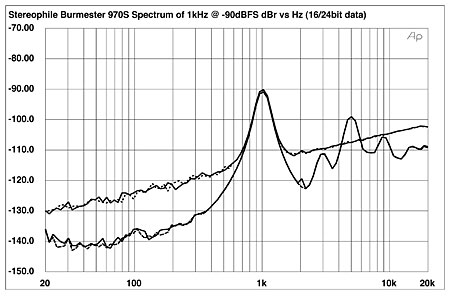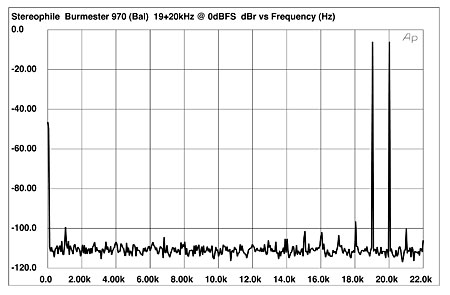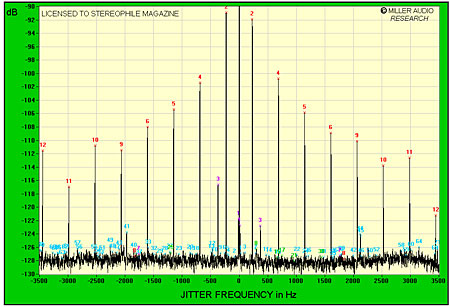| Columns Retired Columns & Blogs |
Burmester Reference Line 970 D/A converter & 969 CD transport Measurements
Sidebar 4: Measurements
Because of the Burmester 970's large number of permutations of digital and analog filters, I performed most of the measurements at the fixed outputs and at the MaxRez/Sharp digital filter and Linear analog filter settings used by KR for most of his auditioning. I checked other settings as appropriate.
The Burmester didn't invert signal polarity from any of its outputs (the XLR jacks are wired with pin 2 hot). Its maximum output from the fixed-level outputs was 4.047V (balanced) and 2.025V (single-ended), sourced from 132.6 ohms and 66.5 ohms, respectively. Channel separation (not shown) was better than the analog noise floor below 500Hz, but decreased at 6dB/octave above that frequency to reach a still negligible 96dB at 20kHz.
The frequency response was identical from both balanced and unbalanced outputs, though, as can be seen from fig.1 (top traces), the Slow digital filter setting rolled off the top octave above 12kHz. The response with de-emphasis (fig.1, lower traces) was only slightly different from that without. The Burmester successfully locked on to all data rates up to 96kHz; the extended response at the higher sample rate can be seen in fig.2. The traces in fig.1 and at the top of fig.2 were taken with the analog filter set to Linear. The bottom pair of traces in fig.2 show the response with this filter set to Soft: as well as a slighter greater top-octave rolloff, the Soft setting drops the overall level by a very audible 2dB.

Fig.1 Burmester 970, unbalanced frequency response at 0dBFS (top), MaxRez with Sharp (top) and Slow (bottom) digital filters, and response at –12dBFS with de-emphasis (bottom), at 44.1kHz sample rate. (Right channel dashed, 0.5dB/vertical div.)

Fig.2 Burmester 970, balanced frequency response at 0dBFS at 48kHz and 96kHz sample rates, with Linear (top) and Soft (bottom) analog filters. (2dB/vertical div.)
The top pair of traces in fig.3 is a spectral analysis, made with a swept 1/3-octave-wide bandpass filter, of the Burmester's output while it decoded data representing a dithered 1kHz tone at –90dBFS. No spuriae or power-supply components can be seen, and the smooth noise floor is actually that of the signal's dither content. Increasing the data bit depth to 24 bits and repeating the measurement resulted in the bottom pair of traces. Again, no spuriae can be seen, and the noise floor is now around 21dB lower, implying between 19 and 20 bits of dynamic range. This is excellent—better than the delta-sigma mbl 1611HR, and effectively equal to the Mark Levinson No.360.

Fig.3 Burmester 970, MaxRez/Sharp, spectrum of dithered 1kHz tone at –90dBFS, with noise and spuriae, 16-bit (top) and 24-bit (bottom) data. (Right channel dashed.)
Fig.3 was made with the processor set to MaxRez. Switching to the STD filter, which causes a "20" to appear on the unit's display, gave an identical result with 16-bit data from CD (fig.4, top traces). But now when the word length was increased to 24 bits, there was a drop in the noise floor only below 1kHz. As can be seen from the bottom traces in fig.4, distortion components appeared above that frequency, presumably due to the truncation from 24 to 20 bits. If you have access to sources with greater than 16-bit resolution, you should always set the 970 to MaxRez.

Fig.4 Burmester 970, "STD/20" spectrum of dithered 1kHz tone at –90dBFS, with noise and spuriae, 16-bit (top) and 24-bit (bottom) data. (Right channel dashed.)
Linearity was excellent when the Burmester decoded both 16- and 24-bit data (fig.5), though slightly more error is noticeable in the right-channel trace than in the left. The good linearity and low noise floor resulted in textbook reproductions of both 16- and 24-bit versions of the waveform of an undithered 1kHz sinewave at –90.31dBFS (figs. 6 and 7).

Fig.5 Burmester 970, departure from linearity: 16-bit data (top), 24-bit data (bottom). (Right channel dashed, 2dB/vertical div.)

Fig.6 Burmester 970, waveform of undithered 1kHz sinewave at –90.31dBFS, 16-bit data.

Fig.7 Burmester 970, waveform of undithered 1kHz sinewave at –90.31dBFS, 24-bit data.
Levels of distortion were also extremely low, with only a faint trace of second-harmonic distortion apparent at the unbalanced outputs (fig.8), and even less at the balanced outputs (not shown). Similarly, intermodulation distortion was also very low (fig.9).

Fig.8 Burmester 970, balanced spectrum, DC–1kHz, 50Hz at 0dBFS, 100k ohm load (linear frequency scale, 20dB/vertical div.).

Fig.9 Burmester 970, unbalanced HF intermodulation spectrum, DC–22kHz, 19+20kHz at 0dBFS, 100k ohm load (linear frequency scale, 20dB/vertical div.).
It was only on our standardized test for word-clock jitter that the Burmester 970 stumbled. I feed the processor under test with an analytical signal developed by British digital engineer Julian Dunn. It consists of a combination of a high-level tone at one quarter the sample rate and the 16-bit data's LSB toggling at approximately 229Hz. To test the Burmester, the signal was derived from a CD-R with low time-base error and played back on a PS Audio Lambda transport, this connected to the 970 with an ST-optical datalink. Any word-clock jitter will manifest itself as symmetrical pairs of sidebands to either side of the primary tone.
Fig.10 shows a narrow-band FFT-derived spectrum of the Burmester's analog output signal, calculated by the Miller Audio Research Jitter Analyzer while the processor decodes this signal. The graph is centered on the frequency of the 11.025kHz tone. The jitter level under these conditions was extremely high: 1710 picoseconds, or more than 10 times as high as what I've measured from other high-end processors. There are pairs of non–data-related sidebands present, at ±15.6Hz and ±372Hz (purple "1" and "3" markers), but most of the jitter appears as sidebands at the signal frequency of 229Hz and its harmonics (red markers).

Fig.10 Burmester 970, high-resolution jitter spectrum of analog output signal (11.025kHz at –6dBFS with LSB toggled at 229Hz). Center frequency of trace, 11.025kHz; frequency range, ±3.5kHz.
KR noted that the sound did improve when the 970 was used with the clock-linked 969 transport, so I must assume that the jitter did drop under these circumstances. (I did not have the 969 available for measurement.) But I suspect that it is only because the 970 performs so well in the other, more conventional areas of measured performance that this high level of clock jitter did not have a more deleterious effect.—John Atkinson
- Log in or register to post comments



































